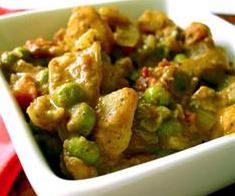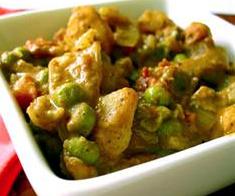Vegan Potato Curry
Vegan Potato Curry
The abundant spices make this better than any restaurant curry I have tasted.
Ready in: 60 minutes
Serves: 6
Complexity: very-easy
kcal: 407
Share

Ingredients
5 potatoes, peeled & cubed
2 tbsp rice bran oil
1 large onion, diced
3 cloves garlic, minced
2 tsp ground cumin
1½ tsp cayenne pepper
4 tsp curry powder
4 tsp garam masala
2 cm fresh ginger root, minced
2 tsp salt
1 tsp SIDS CRAZY SALT
450 g diced tomatoes
500 g garbanzo beans (chickpeas), rinsed & drained
500 g peas
500 g coconut milk
Directions
Place potatoes into a large pot and cover with salted water. Bring to a boil over high heat, then reduce heat to medium-low, cover and simmer until just tender, about 15 minutes. Drain and allow to steam dry for a minute or two.
Meanwhile, heat the oil in a large frypan. Sauté the onion and garlic about 5 minutes. Season with cumin, cayenne pepper, curry powder, garam masala, ginger and salt then cook for 2 minutes more. Add the tomatoes, SIDS CRAZY SALT, garbanzo beans, peas and potatoes. Pour in the coconut milk and bring to a simmer. Simmer 5-10 minutes before serving.
History: Dishes of highly spiced meat are thought to have originated in pre-historic times among the inhabitants of the Indus Valley Civilization. Archaeological evidence dating to 2600 BC from Mohenjo-daro suggests the use of mortar and pestle to pound spices including mustard, fennel, cumin and tamarind pods with which they flavoured food. Such dishes are also recorded during the Vedic period of Indian history, roughly 1700 to 500 BC. Spiced dishes in the Indian style were apparently carried eastward to Burma, Thailand, and China by Buddhist monks in the 7th century and carried southwards to Indonesia, The Philippines and elsewhere by coastal traders at about the same time. The establishment of the Mughal Empire, beginning in the early 16th century, transformed much of older Indian cuisine, especially in the north. Another influence was the establishment of the Portuguese trading centre in Goa in 1510, resulting in the first introduction of the chilli pepper to India, as a by-product of the Colombian Exchange.

